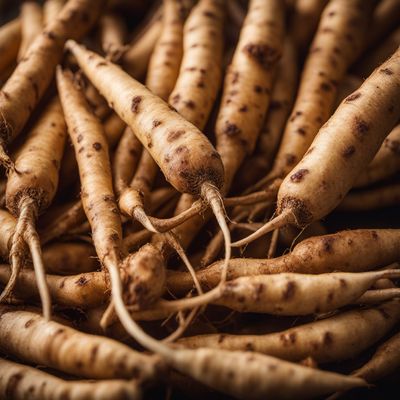
Ingredient
Konjac roots
The Versatile Wonder: Unveiling the Potential of Konjac Roots
Konjac roots, also known as konnyaku or devil's tongue, are tuberous roots native to East Asia. They have a gelatinous texture and a neutral taste, making them a blank canvas for flavors. Konjac roots are often used to make konjac jelly, noodles, and other plant-based alternatives. They are particularly popular in Japanese, Chinese, and Korean cuisines.
Origins and history
Konjac roots have a long history of culinary and medicinal use in East Asia. They have been cultivated and consumed for over 2,000 years, primarily in Japan and China. Konjac products, such as konjac jelly and noodles, have gained popularity worldwide due to their low-calorie content and high fiber content. In addition to their culinary applications, konjac roots are also used in traditional medicine for their potential health benefits.
Nutritional information
Konjac roots are low in calories and high in dietary fiber, making them a suitable choice for weight management and digestive health. They are also rich in glucomannan, a type of soluble fiber that may help lower cholesterol levels and promote feelings of fullness.
How to select
When selecting konjac roots, look for firm and plump roots with a smooth texture. Avoid any roots that are soft, discolored, or have a foul odor. Konjac products, such as konjac jelly or noodles, can be found in Asian grocery stores or specialty health food stores.
Storage recommendations
To store konjac roots, keep them in a cool and dry place, away from direct sunlight. If the roots are fresh, they can be stored in the refrigerator for up to two weeks. Konjac products, such as konjac jelly or noodles, should be stored according to the manufacturer's instructions.
How to produce
Konjac roots can be grown in home gardens or containers. They require a warm and humid climate, making them suitable for regions with tropical or subtropical climates. The roots can be propagated from corms or purchased as young plants. They prefer well-drained soil and regular watering.
Preparation tips
Before using konjac roots, they need to be properly prepared to remove any bitterness or odor. This typically involves boiling the roots for several minutes and then rinsing them thoroughly. Konjac roots can be used to make various dishes, such as stir-fries, soups, and salads. They can also be used as a substitute for noodles or rice in low-carb or gluten-free recipes.
Culinary uses
Konjac roots are commonly used to make konjac jelly, noodles, and other plant-based alternatives. In Japanese cuisine, konjac jelly is often served as a dessert or added to fruit salads. Konjac noodles, known as shirataki noodles, are popular in Asian-inspired dishes and are a low-calorie substitute for traditional pasta. Konjac roots can also be used as a thickening agent in sauces and soups.
Availability
Konjac roots are primarily cultivated in Japan, China, and other East Asian countries. They are also available in specialty stores or online retailers that cater to plant-based or gluten-free diets.


